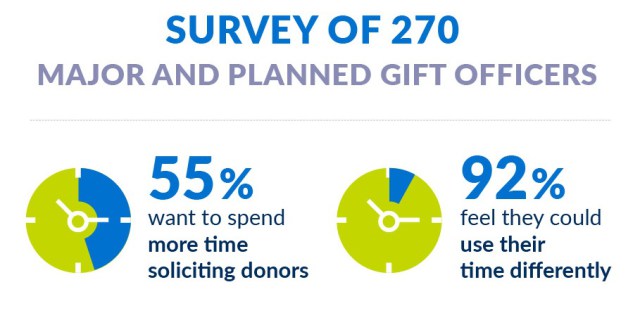fundraising
Key insights from our major and planned giving survey
We’ve just released the results of one the largest surveys ever of major and planned gift officers. We asked these fundraisers—who are responsible for working with the biggest donors to higher education and other charities—about their challenges and opportunities. The results paint a difficult scenario for top fundraisers:
- 92% of gift officers want to spend their time differently.
- 55% want to spend more time on solicitation—meeting directly with donors.
- The average gift officer has 142 identified prospects assigned, but only makes 74 visits a year.
- Less than a third say that they find wealth and propensity ratings “highly effective” in helping them determine which donors to approach.
- On average, gift officers only feel that 37% of their assigned prospects are truly qualified to make a gift.
This is a time when big gifts are needed to make up budget shortfalls and economic challenges, especially in education. Major and planned gift officers don’t seem to have the tools they need to connect to the best donors. And it’s made worse by the fact that gift officers are more likely to be judged by activity (number of visits) rather than effectiveness.

Helping fundraisers be more productive is more than just a way to increase giving. It also serves donors and increases their satisfaction with giving. Productive fundraisers also use a donor’s time wisely, as well as the resources of the organization—which have come from contributions.
How do we increase productivity for major and planned gift officers?
Two key shifts will help. First, prospect research needs to move from passive to active. Right now, fundraisers generally send a ton of communications to potential givers, but don’t necessarily listen as closely as they should to those donors. This requires truly interactive tactics like surveying donors and having good conversations before a meeting.
We can also now watch how donors respond digitally—if they open, if they read, and where they click—so we are connecting them to the opportunities they really care about. This means that when you meet with a donor, you’ll connect them to their giving passion more quickly.
The second big leap is moving from descriptive to predictive in using donor data. Wealth ratings certainly help describe the potential donors in your pool with the highest capacity. But they do little to predict who is ready to give now. That takes advanced multi-variable predictive modelling, and most organizations need help with that.
Respondents to the survey told us that they see a significant opportunity to work with transformational donors. But time and resource pressure are the primary barrier to success. It’s time for some game-changing solutions.
Download the full study today, which includes quotes from major and planned gift officers along with our take on the results.
And if you’d like to take your major and planned donor identification program to the next level in a cost-effective and donor-centric way, drop me a line.